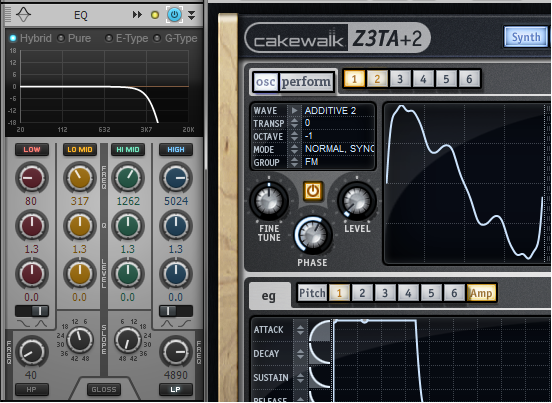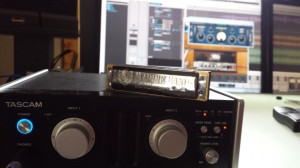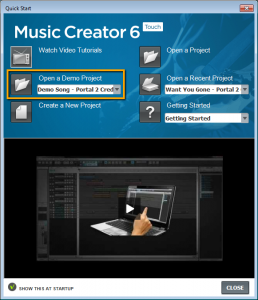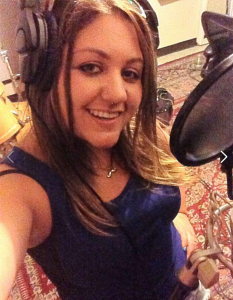Synths can make perfect sounds…but is that always a perfect solution?
by Craig Anderton
Recording a virtual instrument is simple…you just insert it, hit a few keys, and mix it in with the other tracks. Right?
Well…no. Synthesizers are musical instruments, and you wouldn’t mic a drum set by taking the first mic you found and pointing it the general direction of the drummer, nor would you record an electric guitar by just plugging it into a mixing console. A little extra effort spent on avoiding an unnatural sound when mixing synths with acoustic instruments, improving expressiveness, tightening timing inconsistencies, and other issues can help you get the most out of your virtual instruments.
But first, remember that “rules” were made to be broken. There is no “right” or “wrong” way to record, only ways that satisfy you to a greater or lesser degree. Sometimes doing the exact opposite of what’s expected gives the best results. So take the following as suggestions, not rules, that may be just what the doctor ordered when you want to spice up an otherwise ordinary synth sound.
THE SYNTHESIZER’S SECRET IDENTITY
The paramount aspect of recording a synth is to define the desired results as completely as possible. Using synths to reinforce guitars on a heavy metal track is a completely different musical task from creating a all-synthesized 30-second spot. Sometimes you want synths to sound warm and organic, but if you’re doing techno, you’ll probably want a robot, machine-like vibe (with trance music, you might want to combine both possibilities).
So, analyze your synth’s “sonic signature”—is it bright, dark, gritty, clean, warm, metallic, or…? Whereas some people attach value judgements to these different characteristics, veteran synthesists understand that different synthesizers have different general sound qualities, and choose the right sound for the right application. For example, although Cakewalk’s Z3TA+ is highly versatile, to my ears its natural “character” is defined, present, and detailed.
Regarding sonic signatures, perhaps one of the reasons for a resurgence in analog synths sounds is digital recording. Analog synths tended to use low-pass filters that lacked the “edgy” sound of digital sound generation. Recording the darker analog sounds on analog tape sometimes resulted in a muddy sound; but when recording on digital, analog sounded comparatively sweet. Digital also captured all the little hisses, grunts, and burps that characterized analog synths. This is a case where the “imperfections” of analog and the “perfection” of digital recording complemented each other.
Another thought: look at guitars, voices, pianos, etc. on a spectrum analyzer, and you’ll note there is little natural high end. If you’re trying to blend a virtual instrument in with physical instruments, remember that a virtual synth has no problems obtaining a solid high end. Using the ProChannel’s LP filter set to 48dB/octave and lowering the frequency just a little bit can introduce the “imperfection” that matches the spectral characteristics of “real” acoustic and electric instruments more closely, so the synth seems to blend in better with the other tracks (Fig. 1).
Fig. 1: The ProChannel QuadCurve EQ’s lowpass filter can help digital synths sit better in tracks that use multiple physical or acoustic instruments. Continue reading “Recording Virtual Synthesizers: The Art of Imperfection”









 Recently, Cakewalk worked with the great folks over at
Recently, Cakewalk worked with the great folks over at 
 Seems there’s an app for EVERYthing these days. In the recording world, I like to think of plugins as the “apps.” I’ve been part of approximately 16.25 trillion sessions and not a-one has gone by that I haven’t run into a horrible kick drum sound – clicks, flaps, slaps, flops or just generally sounding like a basketball being dribbled through my mic. The flip-side to these tones of course, is that Gawd-awful weak kick drum that sounds like an egg-beater hitting a pillowcase.
Seems there’s an app for EVERYthing these days. In the recording world, I like to think of plugins as the “apps.” I’ve been part of approximately 16.25 trillion sessions and not a-one has gone by that I haven’t run into a horrible kick drum sound – clicks, flaps, slaps, flops or just generally sounding like a basketball being dribbled through my mic. The flip-side to these tones of course, is that Gawd-awful weak kick drum that sounds like an egg-beater hitting a pillowcase. Drum replacement happens EVERYwhere, ALL the time, so don’t let anyone fool you… the key is knowing how to keep the feel and dynamics alive. I learned a lot about drum replacement from producer Beau Hill (Ratt, Eric Clapton, Alice Cooper, etc.), who took me under his production wing and mentored me on many techniques. In music production, we all strive for the best drum sounds because after all, that is what the rest of the music sits on. Unfortunately, we can’t all afford fancy tracking rooms where the walls move to adjust to the natural reverb. So, many of us at one point or another are slaves to the machine: tracking drums in the jam room, or in mom’s garage next to the washing machine (which is constantly on for some reason).
Drum replacement happens EVERYwhere, ALL the time, so don’t let anyone fool you… the key is knowing how to keep the feel and dynamics alive. I learned a lot about drum replacement from producer Beau Hill (Ratt, Eric Clapton, Alice Cooper, etc.), who took me under his production wing and mentored me on many techniques. In music production, we all strive for the best drum sounds because after all, that is what the rest of the music sits on. Unfortunately, we can’t all afford fancy tracking rooms where the walls move to adjust to the natural reverb. So, many of us at one point or another are slaves to the machine: tracking drums in the jam room, or in mom’s garage next to the washing machine (which is constantly on for some reason).